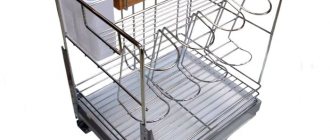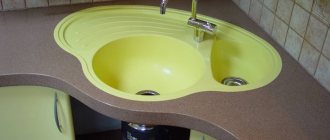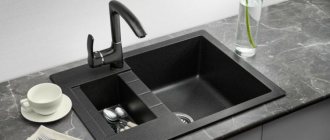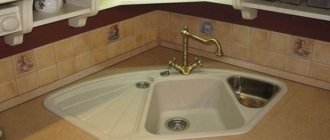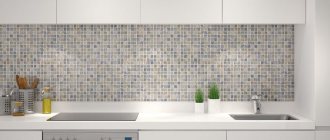Installation of sinks
Dishes need to be washed daily, so it is necessary that the sink is easy and convenient to use. The best kitchen sinks must meet certain user requirements.
Expectations from ideal sinks:
- ease of care;
- ease of use;
- organic combination with the interior of the kitchen;
- minimum sound and splashes.
When installing the sink, it is either mounted on the countertop or embedded into it. Let's look at the methods in more detail.
Countertop installation
The countertop sink allows you to use either a wall-mounted faucet or one mounted on the sink. This installation method saves work space.
Such a sink must have a barrier installed to protect against splashing water, and all joints are treated with sealants.
Mortise installation
With this installation method, sinks are mounted in a special recess in the countertop. This is the most common type of kitchen furniture.
Subtypes of mortise sinks:
- top installation;
- flush;
- bottom installation.
Installation from above is the most practical and simplest method. To do this, simply make a hole in the countertop for the sink bowl. The contours must be treated with sealants.
Most often, flush-mounted sinks are mounted into stone or glass kitchen units. The slot in the countertop should perfectly match the contour of the bottom of the sink. The mixer is installed exclusively on the wall.
Note!
- U-shaped kitchen: pros and cons of the U-shaped layout. Methods of arranging furniture, dividing into working and dining areas. Photos and videos of design ideas
Kitchen facades: TOP 180 photos and video reviews of kitchen facades. Types of frames, criteria for choosing materials and color solutions
- Short curtains for the kitchen - features of using short curtains in small and large kitchens. Advantages and disadvantages of fabric materials (photo + video)
The most difficult part is installing the sink at the bottom. With this method, it is located under the countertop. The mixer is installed at the discretion of the user.
Types of installation of kitchen sinks
Kitchen sinks are an indispensable attribute that no modern kitchen can do without. In the recent past, the consumer's choice of this device was limited to almost a single type - a white enamel sink, which was available in the homes of millions of our compatriots. Now the choice of sinks is simply huge, they differ from each other in shape, size, color, material, as well as installation method, depending on the different types of kitchen units and surfaces on which installation is intended.
What type of installation is best for a sink?
Built-in sink.
Installation of such sinks is done by cutting them into the countertop of the kitchen unit. Almost anyone can install it into an MDF surface, since, as a rule, there are no difficulties. If the kitchen working surface is made of stone or hardwood, then the installation of this kitchen attribute should be entrusted to specialists. The material used to make the sinks themselves is synthetic stone or stainless steel.
Installation of a mortise sink is carried out directly into the countertop, for which a hole is cut in it corresponding to the dimensions of the sink. As a rule, stainless steel sinks come with a template that makes it easy to cut a hole of the required diameter. If there is no such template or a stone sink is being installed, then the following procedure should be followed:
- mark the location of the sink on the countertop;
- Place the sink on the countertop “face down” and outline its outline with a pencil;
- Having removed the sink, draw another circle inside the resulting circle, 1 cm smaller than the previous one;
- cut a hole along the second (smaller) diameter;
- Install using existing fasteners.
This type of sink is most in demand among consumers due to its varied design, different shapes and sizes, as well as the presence of additional accessories (cutting boards, baskets, dispensers and other devices to optimize the food preparation process).
A type of mortise sink is a sink installed at the countertop level. Such sinks are very aesthetically pleasing, but cannot be installed on all types of surfaces. They are usually installed in surfaces made of plastic or artificial stone. To install such a sink in the countertop, part of the material is cut out along the contour of the future sink to the thickness of its side, which is recessed into the material of the countertop. Such sinks are made from stainless steel and artificial stone. These types of stone sinks are made with a beveled edge so that the sealant used during installation will not be visible when the job is completed.
Kitchen surfaces with such sinks are easy to clean, so they are installed quite often.
Overhead sink.
These types are considered the most budget-friendly and are used mainly in modular kitchens, as well as in free-standing cabinets equipped with sinks. For proper installation of this washing device, it must correspond to the dimensions of the cabinet on which it is installed. Currently, sinks of this kind are in less demand due to the fact that they are inferior in aesthetics to the previous type, but their functionality is quite high. Such sinks, as a rule, are spacious in volume, can have several bowls and have additional space on which you can place dishes during washing and defrost food.
Sinks with a universal installation method.
In addition to the listed types, there are sinks that have a flat edge, allowing them to be mounted both on top of the surface and by cutting inside. Such sinks are made of thicker steel, which makes their installation universal. Such sinks are very convenient to use because they make cleaning the work area easier.
Undermount sinks.
Undermount sinks can only be installed on wooden, plastic, or stone countertops. Since the edges of the cut hole remain open, these types of sinks are not used for countertops made of MDF, chipboard, or laminated chipboard. They are installed under the countertop so that the sides of the sink are below the surface level. This expands the space of the working area, but due to the specifics of installation and the need for special tools, it is advisable to entrust it to professionals.
How to choose the right sink
Ideally, the sink blends into the interior of the room and is installed strictly relative to the location of the water supply. When creating a project, turn to the Internet.
Having found the photo of the kitchen sink you need, come up with an assembly plan. Having decided on the method of installing the sink, it remains to understand a few more characteristics of kitchen sinks.
How many bowls can a sink have?
A single sink has gained quite a lot of popularity among housewives, but some users find it more convenient to handle several sinks at the same time.
There are bowls:
Note!
Water filter for the kitchen: functions and benefits of a water filter in the kitchen. Types of filters and mechanisms, their pros and cons (photo + video)- Kitchen in high-tech style: 135 photos and video master class on organizing space and design
Kitchen in modern style - 160 photos of the best design options and features of the style
- single;
- steam rooms with identical bowls;
- steam rooms with different bowls;
- triples.
A sink with a single bowl is used directly for its intended purpose - for washing dishes.
A double kitchen sink with identical compartments is easy to clean and multifunctional. For example, in one compartment you can wash, and in another you can soak kitchen utensils.
A paired sink with distinct bowls is also very convenient. For example, utensils can be soaked in one, and vegetables can be peeled in the next one.
A triple sink is also versatile, but it takes up a significant portion of the kitchen space.
Choosing material
Metal and composite sinks are in greatest demand. Online stores also offer options made of ceramics and copper. Many brands coat products with antibacterial impregnations, which increase the hygiene of washing. Let's take a closer look at the most popular types of materials.
Stainless steel
High-quality products are made from alloy steel grade 18/10 (18% chromium + 10% nickel). Wall thickness 0.4 - 1.2 mm. The most optimal in terms of resistance to mechanical stress are models with walls from 0.6 mm.
Steel sinks for the kitchen do not please with the variety of colors and textures: regular and mirror polishing, matte chrome, decorative textures.
Stainless steel sink built-in under the countertop.
The main advantages are the optimal combination of price, reliability, style, ease of maintenance and installation.
Copper
Another specific representative of the kitchen interior is a copper sink. This product will be a highlight of a retro interior, country and vintage styles. Manufacturers offer several textures: copper gloss or antique aged version.
Copper has high antibacterial properties. The price is more budget than premium.
In metal models, the noise of water is very audible, which can be a limitation for a combined kitchen or apartment with poor sound insulation. Remember that the cost of a metal sink with thick walls is higher than that of lightweight options.
Fake diamond
Standard composition: stone chips (marble, granite) + adhesive components, acrylic. This is a fairly durable composition, resistant to temperature changes, moisture and dyes.
Built-in sink made of artificial stone.
Many brands provide a long warranty period for such sinks. The arguments in favor of a higher priced stone sink are as follows:
- durability;
- variety of design (color, shape, texture);
- water-repellent properties.
Cons: high price (compensated by high performance); heavy weight An artificial stone sink should not be washed with powder; it is better to choose a liquid product without chlorine and other aggressive chemicals.
Based on reviews from the forums, it is clear that the limiting factor when choosing a steel or granite sink for the kitchen is the high price of the latter option.
Ceramics
When choosing a ceramic sink, you can be sure that the product is 100% environmentally friendly. Ceramics for sinks are available in two varieties - porcelain and earthenware.
Modern ceramic sinks are durable, hygienic and easy to maintain. They are coated with glaze to improve water and grease repellent properties.
A classic ceramic sink will perfectly complement the delicate design in the style of shabby chic, Provence.
However, high-quality ceramics are expensive.
Drain
All sinks have a drain. For convenience, it may have a lid that allows you to fill the bowl with the required volume of water. If water is poured quite frequently, sinks with overflow are recommended.
Note!
Glass kitchen apron - 130 photos of a stylish and beautiful kitchen apron in modern interior design- Kitchen studio - 155 photo examples of how to make a large kitchen stylish, spacious and comfortable
MDF kitchen apron: advantages and disadvantages of the material. Varieties of MDF aprons. Features of external decoration. DIY installation instructions (photo + video)
Form
A square or rectangular sink with different bowls is one of the most practical configurations. A round kitchen sink makes efficient use of kitchen space.
When installed in a corner, a corner kitchen sink is suitable. In small rooms it is best to install a single sink with a platform.
Sink and its dimensions
When choosing this sanitary product for the kitchen, you need to pay attention to the shape and dimensions.
For example, you already have a set with a sink cabinet, then this will be your starting point in finding the best option for this kitchen utensil.
When going to the store to make a purchase, you need to remember the dimensions of the existing cabinet or the planned sink space and then individually order the entire kitchen unit as a whole.
The standard cabinet is designed for sinks with dimensions of 0.5x0.6 m. In the case of a non-standard tube size exceeding 0.9 m, choosing a corner sink would be an acceptable option.
The choice of sink size is also influenced by the dimensions of the kitchen itself, because you must admit that it would not be rational to have a huge two-cup sink in a small and narrow kitchen or, on the contrary, in a spacious kitchen with a large work surface to have a standard sink with small dimensions.
Note! Kitchen in kitsch style: an interior you can be proud of! 100 real photos.
What are sinks made of?
Currently, there are many materials that are used in the manufacture of sinks.
Sinks are made from:
- of stainless steel;
- artificial stone;
- ceramics;
- cast iron;
- glass;
- natural stone;
- copper;
- bronze;
- polymers.
Let's consider the characteristics of the most popular materials.
Disadvantages of a built-in sink
An integrated sink is not ideal; it has its disadvantages:
- Difficulty replacing the sink. If it is necessary to replace the sink (technical damage, change in the style of the kitchen as a whole, replacement with a newer one), the entire structure will have to be changed, including the countertop. This will entail financial costs and also increase the volume of work performed. At the same time, only specialized organizations are engaged in replacing sinks.
- It is not recommended to install a food waste disposer. Because the sink and countertop are connected by an invisible seam (technically it is often not a monolithic
structure), the kitchen grinder transmits vibration to the sink as it operates. As a result, over time, the seam may “open up”. The exception is a sink with a stainless steel bottom. - The integrated cultured stone sink is prone to staining. The sink surface reacts to sudden temperature changes. To minimize the appearance of stains, a tray made of a more durable material is used, most often stainless steel.
- Complex design. A monolithic sink is a custom-made product that is large in size. Therefore, its installation will require skill and professionalism. If you are installing such a sink yourself and for the first time, you will need additional help.
- Scratches may occur. An integrated sink made of acrylic stone is not a very durable material. If the surface is accidentally damaged while washing dishes, scratches may appear, which become clogged with dirt over time. On light-colored material, dark chips will be more noticeable.
- Fear of very high temperatures. Artificial stone does not like boiling water. It can react to such aggression from the owner with a cracked surface.
- High cost of washing. Anything custom made costs more. Therefore, if you decide to order a monolithic sink, be prepared to overpay, or consider alternative offers.
Integrated sink made of artificial stone
Stainless steel
Stainless steel is most often used in the manufacture of sinks. But not all types of steel respond equally well to external influences. If you buy a sink from a dubious manufacturer, you may soon find signs of corrosion on it.
You should choose stainless steel kitchen sinks from popular manufacturers. Promoted organizations do not skimp on material.
The disadvantage of this material is that scratches remain on it if handled carelessly, which are difficult to remove. The least dirt and scratches are visible on a matte finish.
Features of caring for an integrated kitchen sink
Any item needs care. Even minimal. After all, its service life depends on this. Since the sink is one of the most dirty places in the kitchen, it requires constant care. Considering that it is made of acrylic, care will be a little special.
After the last wash of dishes (before going to bed or before leaving for work), it is recommended not to leave the monolithic artificial stone sink wet. Wipe with a clean, dry cloth and the sink will last a very long time.
Since acrylic stone does not like very high temperatures, do not pour boiling water or place dishes from the stove onto the sink. This way you will avoid damage to the material.
When using cleaning products, choose creamy, mild chemicals, because integrated sinks are “afraid” of coarse abrasive substances that leave small scratches on the acrylic surface. How to choose a WASH for your KITCHEN? Useful tips and personal experience! Video
Fake diamond
A fairly common resource, like steel. Sinks made of artificial stone are very beautiful, and they are highly resistant to external influences.
This material does not make sounds, is not affected by chemicals and does not corrode. Most often, stone sinks are made of porcelain stoneware, acrylic stone and agglomerate.
Selection of sink material
The main criterion in choosing a sink material is the compatibility of all elements of the kitchen interior. The photo of kitchen sinks shows materials that have proven themselves in use: stainless steel, ceramics and artificial stone.
Stainless steel kitchen sinks are in great demand among buyers due to their excellent anti-corrosion properties. When purchasing such a sink, it is important to pay attention to the sound absorber located under the bowl. Modern and high-quality sound-absorbing materials will ensure low noise levels for your sink. An additional advantage of stainless steel is its shiny, matte or textured surface.
Advice! A magnet will be an assistant in determining a high-quality stainless steel kitchen sink. Good stainless steel (an alloy of chromium and nickel) will ensure that the magnet slides easily over the surface of the sink.
Read: Kitchen facades - the best ideas for beautiful facades in the kitchen interior (70 photos)
Ceramic sinks are a stylish and effective solution for your kitchen. A ceramic sink will not let you down if you are defrosting food or cooling a hot pan in it. There will be no scratches from cutlery or knives. However, an unforeseen heavy load or impact can break such a sink due to the fragility of ceramics.
Kitchen sinks made of artificial stone, made of stone chips, special resins and pigments, can also satisfy the most demanding taste! The colors of such sinks and imitation of various types of natural stones can be infinitely varied.
The quality of washing directly depends on the production technology of the material. The advantages of composite sinks are environmental friendliness and low noise level when the water is turned on.
When choosing an artificial stone, it is worth remembering that stone made on the basis of acrylic resins is susceptible to scratches, which, however, can be easily removed by polishing the surface. To make this sink last longer, it is not recommended to place too hot dishes on its surface.
An alternative to acrylic are granite sinks, which, due to their characteristics, provide not only a beautiful visual effect, but also demonstrate ease of use and maintenance, as well as a temperature limit of use up to 280 0C.
Advice! A detailed study of manufacturers' recommendations for handling and caring for a kitchen sink will allow you to make an informed choice and extend the service life of the product.
Cast iron
Cast iron sinks are quite heavy, very reliable, but can crack under heavy mechanical stress. In most cases, such products are mounted on the wall.
Enamel does not withstand exposure to abrasive materials. For care, it is recommended to use soft fabrics.
Sink material
Like any product, kitchen sinks can be made from different materials. Each of them has its own advantages that may be suitable in a particular situation.
Tablecloth for the kitchen table - 82 photos of amazing ideas of beauty and practicality- Decoration of a gas pipe in the kitchen: how to hide it without hiding it in the wall? 54 photos of ideas and beautiful solutions
Tiles on the kitchen walls - how to choose and stick correctly? Instructions + 65 photos
Let's find out in more detail what sinks for our kitchens are made of.

